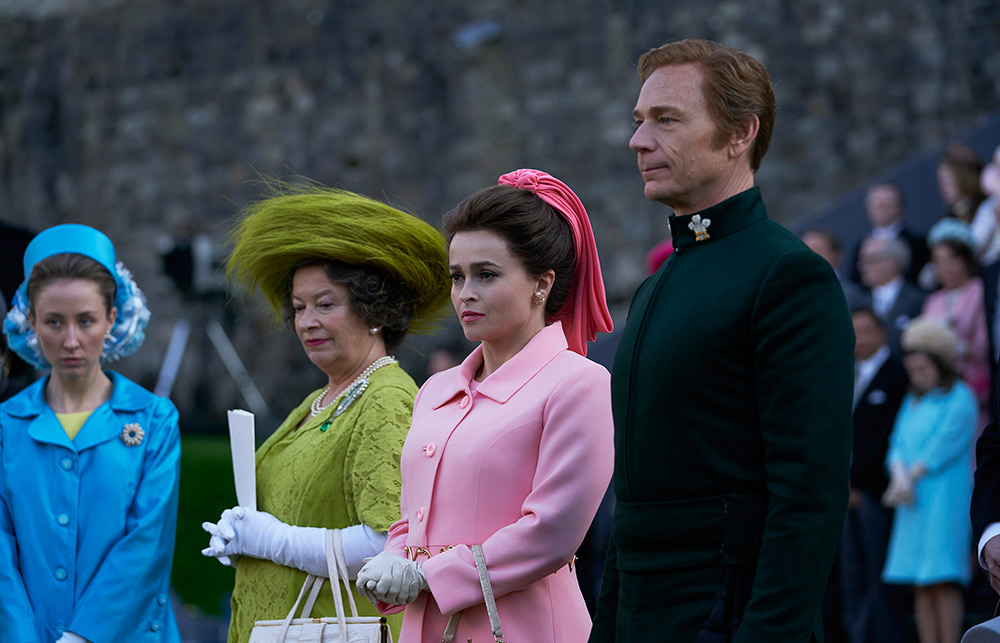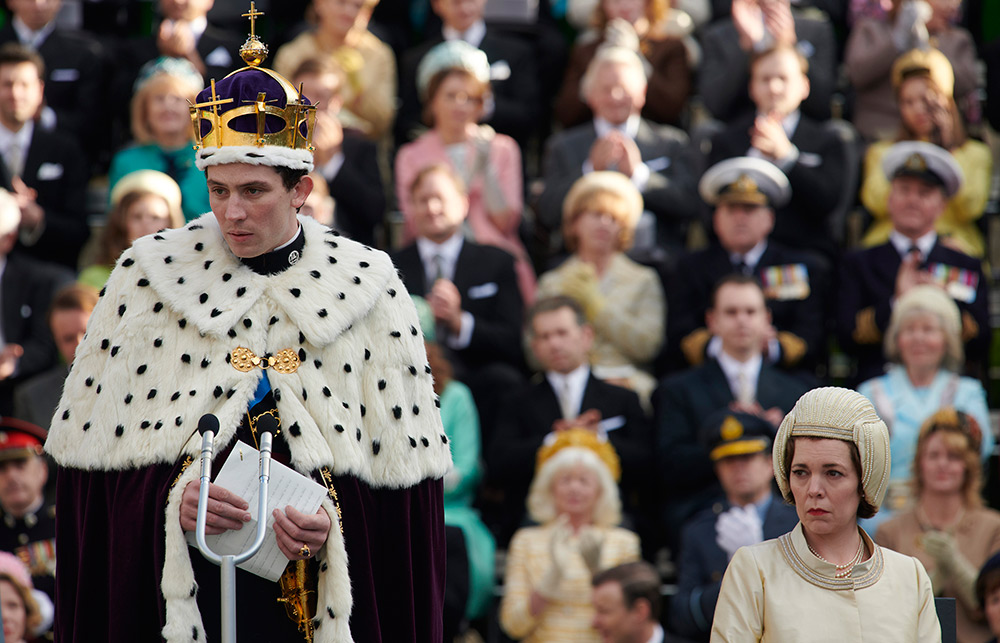《王冠》进入第三季,华丽依旧
2016年Netflix的《王冠》(The Crown)刚开播,就立刻吸引了评论家和观众。剧中随处可见奢华布景和服装、知名演员阵容,还有宏大的音乐,剧情是从1940年代开始的伊丽莎白二世的生活。
该剧播出后好评如潮,11月将迎来下一季。今年第三季在艺术指导和古装类别获得艾美奖(Emmy Awards)的多项提名。正如人们所料,从《财富》杂志与艺术指导马丁·查尔兹和第三季服装指导艾米·罗伯茨的对话来看,为如此宏大的作品设计服装和造型需要大量研究,也涉及一些非常具体的流程。
查尔兹从一开始就参与剧集制作,他说第一季后开发了系统,在一张纸中间画出一集剧情主要地点,比如白金汉宫或温莎城堡。然后画上一些箭头和其他信息。现在变成“几乎每个人都想要份拷贝。感觉一张纸就能读懂剧本。”他说。
“对我来说,画图的好处在于理顺叙事的顺序。”查尔兹说,这样一来才可以在不同场景中避免使用相同的颜色或窗口布置,帮助观众理解故事的发展。

制作布景的过程中进行了广泛的研究,例如,将白金汉宫知名区域尽可能地精确复制非常重要。为此,查尔兹在第一季拍摄之前专门参观了皇室官邸。但也有一些部分,比如皇室的私人公寓并无公开记录,查尔兹则利用“合理想象”搭建。
“不得不说,《王冠》里没有任何道具是真实物品的(准确)复制品。”查尔兹说,不过布景风格仍然遵从真实风格。
查尔兹表示,每季约有400种的布景。由于演员阵容有些变化(前两季由克莱尔·芙伊饰演女王,而第三季和第四季由奥利维娅·科尔曼接手),每季中重复利用部分布景有助于从视觉上提醒观众,观众仍然在观看同一部剧。
重复利用布景并不意味着不会在不同地点拍摄,在英国和国外都有。有些地点的戏会在其他地方取景。查尔兹说,刚开始几季里,国外取景有70%都在南非。
“但第三季,我们几乎用尽了南非的取景地,这让人难以置信。”查尔兹说,因此最后在“西班牙小三角”地区拍摄了一些场景。该地拍摄的场景用在了加利福尼亚、亚利桑那和加勒比海地区的剧情中。剧组和剧组也回到西班牙,为即将到来的第四季寻找不同的拍摄地点。
罗伯茨设计服装时也做了大量研究,沉浸在王室成员的照片、书籍和电影中。但后来“全都抛诸脑后”。
“我们不是拍纪录片,这是电视剧。”她解释说。
第三季将观众带入了20世纪60年代和70年代,罗伯茨很兴奋,因为这一时期“王室女性似乎钟爱美丽强烈的色彩。”

女王通常热爱色彩鲜艳的服装,现在也还是喜欢,不过当时最受欢迎的是罗伯茨称之为“甜杏仁”的颜色,比如粉红色和丁香花色,于是服装部门“勇敢大胆”描绘了新时期的时尚。
最近一季里皇室不同世代的差异也更加明显。女王母亲的服装仍然有20世纪30年代的风格,玛格丽特公主和伊丽莎白女王则更贴近A字型等60年代风格,不过相对庄重。另一方面,安妮公主还穿了一些迷你裙。
“再强调一次,不是过分的超短裙,像短到膝盖以上几英寸那种,我们设计的服装并不疯狂。”罗伯茨说。
对罗伯茨来说,最具挑战性的场景是查尔斯王子的授勋仪式,仪式后他正式成为威尔士亲王。其中王冠是为本剧特别制作,长袍制作则面临伦理挑战。
“必须得制作,我们不能用新鲜皮草,所以衬里都用了貂皮,所以我们只得大量采购允许使用的貂皮。”罗伯茨说。

另外,罗伯茨最喜欢的作品是爱丽丝公主的修女服饰。“其他角色用了很多丝绸和花饰,非常花哨,突然出现这样一位特别的角色,简单诚实的菲利普亲王母亲。”她说。“我们得从头开始重新设计……做旧然后打补丁。”
艺术指导方面,重现与王室并无关系的阿伯凡矿难挑战最大,不过查尔兹对故事角度取得的成就还是很自豪。
“这是历史上的真事,是真人经历过可怕的事,有些人还活着,仍然记得——当年我也有印象。”查尔兹说。“目前来看,准确细致地描述矿难是《王冠》电视剧中最困难的一段。”
他补充道:“我们的责任是向世人展示这一骇人听闻的事件如何发生。”
跟其他部门保持沟通是拍摄《王冠》一剧的关键。查尔兹与罗伯茨就密切合作,协调场景中布置的颜色,也经常为视觉效果团队绘制草图讲述意图。
“我不喜欢镜头里特效太多。”查尔兹说,他更喜欢至少三分之二的内容保持真实。“我们的特效团队也非常愿意接受。他们的任务是让特效看起来与布景融为一体。”
随着团队制作的剧集越来越多,幕后团队仍然有应对之法。
随着剧集不断推进,查尔兹也不断调整节奏。他解释说,《王冠》电视剧更像“史诗小说”,处理方式与两小时的电影显然有所不同。
“我得留着点。不能刚开头两个小时就把最好的创意都用上。电影只有两个小时,《王冠》还要拍48集。”他说。
与此同时,今年秋天第四季开播时,观众“将迎来三位著名女性登场,即女王、撒切尔夫人,当然还有戴安娜王妃。他们将踏上真正的旅行,视觉上的旅行。”罗伯茨说。
“我们确实提高了业界水准。”
今年《王冠》获得13项艾美奖提名。首播以来剧集共获得39项提名,迄今已获得8项艾美奖。(财富中文网)
译者:Feb
2016年Netflix的《王冠》(The Crown)刚开播,就立刻吸引了评论家和观众。剧中随处可见奢华布景和服装、知名演员阵容,还有宏大的音乐,剧情是从1940年代开始的伊丽莎白二世的生活。
该剧播出后好评如潮,11月将迎来下一季。今年第三季在艺术指导和古装类别获得艾美奖(Emmy Awards)的多项提名。正如人们所料,从《财富》杂志与艺术指导马丁·查尔兹和第三季服装指导艾米·罗伯茨的对话来看,为如此宏大的作品设计服装和造型需要大量研究,也涉及一些非常具体的流程。
查尔兹从一开始就参与剧集制作,他说第一季后开发了系统,在一张纸中间画出一集剧情主要地点,比如白金汉宫或温莎城堡。然后画上一些箭头和其他信息。现在变成“几乎每个人都想要份拷贝。感觉一张纸就能读懂剧本。”他说。
“对我来说,画图的好处在于理顺叙事的顺序。”查尔兹说,这样一来才可以在不同场景中避免使用相同的颜色或窗口布置,帮助观众理解故事的发展。
制作布景的过程中进行了广泛的研究,例如,将白金汉宫知名区域尽可能地精确复制非常重要。为此,查尔兹在第一季拍摄之前专门参观了皇室官邸。但也有一些部分,比如皇室的私人公寓并无公开记录,查尔兹则利用“合理想象”搭建。
“不得不说,《王冠》里没有任何道具是真实物品的(准确)复制品。”查尔兹说,不过布景风格仍然遵从真实风格。
查尔兹表示,每季约有400种的布景。由于演员阵容有些变化(前两季由克莱尔·芙伊饰演女王,而第三季和第四季由奥利维娅·科尔曼接手),每季中重复利用部分布景有助于从视觉上提醒观众,观众仍然在观看同一部剧。
重复利用布景并不意味着不会在不同地点拍摄,在英国和国外都有。有些地点的戏会在其他地方取景。查尔兹说,刚开始几季里,国外取景有70%都在南非。
“但第三季,我们几乎用尽了南非的取景地,这让人难以置信。”查尔兹说,因此最后在“西班牙小三角”地区拍摄了一些场景。该地拍摄的场景用在了加利福尼亚、亚利桑那和加勒比海地区的剧情中。剧组和剧组也回到西班牙,为即将到来的第四季寻找不同的拍摄地点。
罗伯茨设计服装时也做了大量研究,沉浸在王室成员的照片、书籍和电影中。但后来“全都抛诸脑后”。
“我们不是拍纪录片,这是电视剧。”她解释说。
第三季将观众带入了20世纪60年代和70年代,罗伯茨很兴奋,因为这一时期“王室女性似乎钟爱美丽强烈的色彩。”
女王通常热爱色彩鲜艳的服装,现在也还是喜欢,不过当时最受欢迎的是罗伯茨称之为“甜杏仁”的颜色,比如粉红色和丁香花色,于是服装部门“勇敢大胆”描绘了新时期的时尚。
最近一季里皇室不同世代的差异也更加明显。女王母亲的服装仍然有20世纪30年代的风格,玛格丽特公主和伊丽莎白女王则更贴近A字型等60年代风格,不过相对庄重。另一方面,安妮公主还穿了一些迷你裙。
“再强调一次,不是过分的超短裙,像短到膝盖以上几英寸那种,我们设计的服装并不疯狂。”罗伯茨说。
对罗伯茨来说,最具挑战性的场景是查尔斯王子的授勋仪式,仪式后他正式成为威尔士亲王。其中王冠是为本剧特别制作,长袍制作则面临伦理挑战。
“必须得制作,我们不能用新鲜皮草,所以衬里都用了貂皮,所以我们只得大量采购允许使用的貂皮。”罗伯茨说。
另外,罗伯茨最喜欢的作品是爱丽丝公主的修女服饰。“其他角色用了很多丝绸和花饰,非常花哨,突然出现这样一位特别的角色,简单诚实的菲利普亲王母亲。”她说。“我们得从头开始重新设计……做旧然后打补丁。”
艺术指导方面,重现与王室并无关系的阿伯凡矿难挑战最大,不过查尔兹对故事角度取得的成就还是很自豪。
“这是历史上的真事,是真人经历过可怕的事,有些人还活着,仍然记得——当年我也有印象。”查尔兹说。“目前来看,准确细致地描述矿难是《王冠》电视剧中最困难的一段。”
他补充道:“我们的责任是向世人展示这一骇人听闻的事件如何发生。”
跟其他部门保持沟通是拍摄《王冠》一剧的关键。查尔兹与罗伯茨就密切合作,协调场景中布置的颜色,也经常为视觉效果团队绘制草图讲述意图。
“我不喜欢镜头里特效太多。”查尔兹说,他更喜欢至少三分之二的内容保持真实。“我们的特效团队也非常愿意接受。他们的任务是让特效看起来与布景融为一体。”
随着团队制作的剧集越来越多,幕后团队仍然有应对之法。
随着剧集不断推进,查尔兹也不断调整节奏。他解释说,《王冠》电视剧更像“史诗小说”,处理方式与两小时的电影显然有所不同。
“我得留着点。不能刚开头两个小时就把最好的创意都用上。电影只有两个小时,《王冠》还要拍48集。”他说。
与此同时,今年秋天第四季开播时,观众“将迎来三位著名女性登场,即女王、撒切尔夫人,当然还有戴安娜王妃。他们将踏上真正的旅行,视觉上的旅行。”罗伯茨说。
“我们确实提高了业界水准。”
今年《王冠》获得13项艾美奖提名。首播以来剧集共获得39项提名,迄今已获得8项艾美奖。(财富中文网)
译者:Feb
Netflix’s The Crown caught the eye of critics and audiences alike when its first season premiered in 2016. Lavish sets and costumes, a notable cast, and stately music are all part of the drama series, which chronicles the life of Queen Elizabeth II, starting in the 1940s.
With a new season on its way in November, the series continues to draw accolades; its third season is nominated for various Emmy Awards this year, including in the production design and period costume categories. As one would expect, costuming and coming up with the overall look of such a vast production involves a good amount of research, as well as some very specific processes, according to Fortune’s conversations with production designer Martin Childs and season three costume designer Amy Roberts.
Childs, who has worked on the series from the beginning, says he developed a system after the first season that involves sketching the main location where most of an episode takes place—such as Buckingham Palace or Windsor Castle—at the center of a sheet of paper. Then he draws in some arrows and additional information around that. It’s gotten to a point where “almost everybody wants a copy now. It’s like looking at the script in a one-page guideline,” he says.
“The way that helps me is to know when something in the narrative follows something else,” Childs says, adding that it helps him decide when to avoid using things like the same colors or window arrangements from scene-to-scene—visual cues that help the audience understand the story is moving along.
Extensive research is involved in creating the sets—making well-known areas of Buckingham Palace, for instance, as accurate as possible is important; Childs toured the royal residence ahead of season one. But there are also parts of the set, such as the royal family’s private apartments—which there are no public records of—that are built using what Childs refers to as “informed imagination.”
“I have to say that absolutely nothing in The Crown is [an exact] replica of the real thing,” Childs says, though the style of the sets remains true to the spirit of the real location.
There are probably about 400 different sets used each season, according to Childs. Repeating some of them throughout the seasons, especially as the cast changed (the Queen is portrayed by Claire Foy in the first two seasons, while Olivia Colman took over the role in the third and fourth seasons), helps serve as a visual reminder that audiences are still watching the same characters on the same show.
The use of such sets doesn’t mean the show doesn’t also shoot in different locations, both in the U.K. and abroad, though. Some locations wind up substituting for others onscreen. In the early seasons, South Africa stood in for roughly 70% of the show’s foreign settings, Childs says.
“But season three, we kind of almost exhausted—unbelievably—our South Africa locations,” says Childs, so the production wound up shooting some scenes in “a little triangle of Spain” instead. This region ended up standing in for places such as California, Arizona, and the Caribbean. The cast and crew also returned to Spain to re-create various locations for the upcoming fourth season.
For her part, Roberts also does a tremendous amount of research when designing costumes, immersing herself in photos, books, and films featuring members of the royal family. But then she eventually “throws it all away.”
“We’re not doing a documentary—it’s a drama,” she explains.
Season three, which plunges viewers into the ’60s and ’70s, was exciting for Roberts to work on because of “those extraordinary beautiful, punchy colors that the royal women really seemed to relish.”
While the Queen is generally known for wearing bright colors, even today, that particular period featured what Roberts calls “sugared almond” colors like pinks and lilacs, which allowed the costuming department to jump in “bravely and boldly” to depict a new era.
The most recent season also saw the differences between the various royal generations highlighted more clearly. The Queen Mum’s clothing still has hints of a 1930s silhouette, while Princess Margaret and Queen Elizabeth are in ’60s silhouettes like A-lines, albeit with an element of modesty. Princess Anne, on the other hand, actually sports some miniskirts.
“Again, not outrageous miniskirts—you know, like a couple of inches above her knees, not crazy,” Roberts says.
The most challenging project for Roberts involved Prince Charles’s investiture—the ceremony that formalized his status as Prince of Wales. The crown he wears in those scenes was especially made for the series, while the robe in particular posed something of an ethical challenge.
“That all had to be made, and we quite rightly don’t use fresh fur, so all the lining is ermine, and so we had to source an awful lot of approved ermine,” Roberts says.
Separately, Roberts’s favorite piece to work on was Princess Alice’s nun’s costume. “You’ve got all silks and the florals and the razzmatazz, and suddenly you’ve got this extraordinary character that is Prince Philip’s mother, and simple and honest,” she says. “We had to re-create that from absolute scratch…I had it worn and patched and darned.”
On the production design end, re-creating the Aberfan disaster—establishing a tragedy that did not involve the royal family—was a big challenge, though Childs is proud of what was ultimately accomplished from a storytelling perspective.
“It was a real part of history and a terrible thing that happened to real people, some of whom are still alive and remember it—I was around when it happened,” says Childs. “The responsibility of telling that story well and accurately was like nothing else on The Crown so far.”
“Our responsibility was to show the world that this appalling thing was happening,” he adds.
Communicating with other departments is key when it comes to making The Crown. Childs worked closely with Roberts to coordinate what colors should be established in a scene and often makes sketches for the visual effects team to convey what he wants.
“My preference is to never have too much VFX in any one shot,” Childs says, adding that he prefers that at least two-thirds of what’s seen on the screen is real. “Our VFX people were more than willing to go along with that. Their mission is to make what they do look like part of the set.”
With more seasons to come, the behind-the-scenes team still has some tricks up their sleeves.
Childs, who has been pacing himself as the series progresses, explains that his approach to a series like The Crown, which he compares to an “epic novel,” has to differ from how he treats a two-hour feature film.
“I’ve got to save up a few things. I can’t use all my best ideas in the first two hours, because in a feature film, it would be only two hours. In The Crown, you’ve got another 48 to go,” he says.
Meanwhile, when season four debuts this fall, viewers “can expect three iconic women—the Queen, Margaret Thatcher, and of course, Princess Diana. They can expect real journeys there, visual journeys,” says Roberts.
“I think we’ve really upped our game.”
The Crown is nominated for 13 Emmy Awards this year. The series, which has received a total of 39 nominations since its premiere, has won eight Emmys up until now.













